1. Forecast
1. Macro-level summary and future forecast
The global market is intensifying due to US tariff policies and economic data. US stocks have differentiated. In the past week, the S&P 500 has fallen 0.85%, the Dow Jones Industrial Average has risen 0.32%, and the Nasdaq has fallen 1.12%. The IMF lowered its U.S. economic growth forecast for 2025 to 1.8% (2.7% in January) on April 22 as tariff uncertainty hit trade confidence. The EU and Canada plan retaliated against each other, and inflation expectations rose. Germany's economic growth forecast for 2025 fell to 0%. In the next week, US non-farm employment data, Fed interest rate statements and tariff negotiations will become the focus. If trade frictions intensify, supply chain pressure may push up commodity prices and suppress risky assets, caution should be maintained.
2. Market changes and early warnings in the crypto industry
The crypto market showed resilience and did not decline significantly with the US stock market. Bitcoin approaches $95,000, benefiting from the net inflow of BTCETFs. The Coinbase Institutional report shows that the total market value of the crypto market (except BTC) in Q1 fell slightly, venture capital slowed down, and altcoins confidence was weak. At the regulatory level, the SEC's new regulatory trends on stablecoins and DeFi platforms have attracted much attention and may affect market sentiment. Technically, if Bitcoin has not broken through the recent high, it may backtest the previous support. Investors should disperse their allocations, beware of high-volatility token risks, and pay attention to the long-term potential of blockchain in the fields of payment and decentralized applications.
3. Industry and track hot spots
Decentralized AI platform Fetch.ai has launched an enterprise toolkit that combines AI analytics with blockchain technology for supply chain and healthcare. FET token prices rose month-on-month, thanks to the enhanced data privacy of European logistics partnerships; ReFi project Flowcarbon received a $5 million financing led by a16z to expand its carbon negative emission blockchain and tokenize 10,000 carbon credits on the Polygon platform to fund reforestation; Litentry, the decentralized identity protocol, released its v2.0 identity center, enabling cross-chain identity control for Web3 and DeFi. Cointelegraph notes that Litentry has integratedPolkadotand Ethereum to provide secure authentication support for more than 5,000 dApps, thereby improving user privacy and adoption.
2. Market hot tracks and weekly potential projects
1. Potential track performance
1.1.Analysis of MSafe, a core liquidity engine for Move ecosystem, built on Sui and Aptos, with financing of over $5 million
MSafeWallet (i.e. Momentum Safe) is the first multi-signature, unmanaged digital asset management solution built on Move.
MSafeThe main advantages of wallets
- Security
MSafe wallet solutions eliminate the risk of single point of failure, reduce the risks brought about by transfer of authorized funds by a single person, and provide security for financial institutions, businesses and individuals. Built on Move, MSafe enhances security with its unique chain-level security system that has been audited by several top audit companies. - Decentralization
MSafe implements true decentralization, which is missing in custodial wallets and single-signature uncustodial wallets, and this decentralization is essential to prevent malicious actors from transferring assets from their wallets. - Interoperability
MSafe can be integrated with any Move-based decentralized application (dApp). Whether dApp developers or end users, you can get security and enjoy full interoperability across dApp asset management.
Technical details
MSafe provides developers with a tool for risks in decentralized protocol management. There are two main usage scenarios:
Deploy smart contracts with MSafe
- Deploy smart contracts using an interactive command line interface (CLI).
- (Recommended) Call the MSafe SDK through scripts.
Calling the entry function using MSafe
- Use the interactive command line interface (CLI) to call the entry function.
- (Recommended) Call the MSafe SDK through scripts.
Components
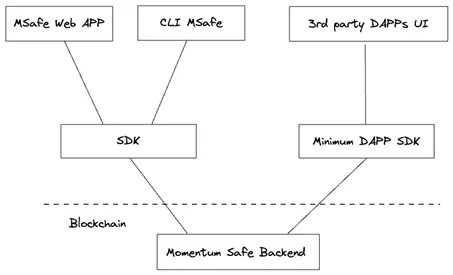
- MSafe rear end: The core part of MSafe. The MSafe backend combines the MOVE module and Aptos native multi-signature multi-ed25519 to implement a multi-signature wallet.
- SDK: TypeScript SDK for interacting with MSafe wallet. The SDK is used by MSafe web applications and MSafe CLI tools and can also be used for external third-party integration.
- WebApply MSafe: A web application interface that interacts with MSafe.
- CLI MSafe: Command line tool to interact with MSafe, supporting MOVE module deployment and smart contract interaction.
- Dapp SDK(for dApp integration): A DAPP SDK that allows third-party dApps to interact with MSafe wallets.
system
Based on the system architecture, the MSafe protocol has the following advantages:
- Security
MSafe is designed to ensure our products have the same level of security as the Aptos core protocol.
Since the final step in MSafe transactions is performed by Aptos' native multi-ed25519 standard, MSafe wallets are secured by the Aptos core protocol. The only potential risk is that the signature functionality implemented in the Aptos core protocol is compromised, but this situation is almost impossible and has been secured through cryptography principles.
This also saves MSafe from facing some other potential security issues in the implementation of smart contract multi-signature wallets, such as dual payments, transaction execution order, etc. These problems have been effectively solved in the Aptos transaction model. - Interoperability
In addition to being used as a wallet, MSafe also makes it possible to interact with other protocols/dApps in the MOVE ecosystem. By using Aptos' native multi-ed25519 wallet, MSafe can send any transaction load supported by the Aptos core, especially calling the entry function of any MOVE module.
This allows MSafe to interact with any system/third-party MOVE module and will support a variety of use cases and features implemented by MSafe, including:
- Treasury management
- Interact with any third-party dApp
- Use the system function publish_function to publish MOVE modules owned by MSafe
- As the administrator account of the MOVE module, controls protocol-level parameters
- True decentralization
In the current design, the data storage method of MSafe is as follows:
- The core data related to transactions (single sign address, MSafe wallet, TxnBook) will be stored in the on-chain MOVE module. This will make the transaction rely on as few other factors as possible and avoid single point failures.
- User-customized/specific data is stored off-chain to provide a better user experience. This data is user-specific and the user may not wish to disclose this data on the chain. Therefore, we provide storage of this data in a centralized database or local storage to provide a better user experience while maintaining flexibility and privacy.
Through this different levels of data storage model, we can provide a decentralized system where the core dependence of transaction execution is only the blockchain itself, and it also provides scalability and flexibility to provide a better user experience.
Interactive CLI
The CLI tool is a command-line interface that interacts with the MSafe wallet. As a professional tool for developers, this tool provides some advanced features.
Features supported by the CLI tool include:
- Wallet creation and registration;
- Transfer APT coins;
- Register another currency (non-APT);
- Transfer other currencies (non-APT);
- Call the entry function;
- Release MOVE modules.
Among them, the 5th and 6th functions are unique to the CLI and are supported only by this tool.
Currently, the CLI only supports Aptos Devnet. Smart contracts will be deployed on long-running Testnet.
Comments
In summary, MSafe wallets have high security, decentralized features and interoperability, and are suitable for developers and enterprises or individuals who require high security management, but the current network support and user-friendliness are relatively low.
1.2.With a financing of over US$11 million, what is unique about Optimum, a high-performance memory infrastructure dedicated to expanding capacity for various public chains?
Optimum is the world's first decentralized high-performance memory infrastructure, aiming to provide any blockchain with extended data access, reduce network burden, and drive the next generation of decentralized applications (dApps). It is based on Random Linear Network Coding (RLNC) technology, a mature data encoding method developed by MIT, Optimum transforms slow and redundant networks into fast, efficient, and scalable systems.
Optimum is a decentralized, flexible nodes network that anyone can run and connect to any blockchain without permission. Through Optimum, the blockchain obtains a memory bus and RAM similar to the performance of modern computers. At the heart of Optimum is to build a proven optimal memory infrastructure that transforms blockchain into a high-speed, scalable computing network. Its architecture is modular, license-free, and easy to integrate through the API.
Optimum’s products include Optimum P2P and decentralized random access memory (DeRAM), providing the following benefits to the entire blockchain ecosystem:
- For validators: Accelerate data propagation, reduce operating costs, increase annualized income (APY) and miner proposal (MEV) revenue
- For L1 and L2 blockchains: Accelerate block propagation, reduce bandwidth consumption, and optimize storage
- For dApp developers: Improve transaction relay and priority processing, support low latency, high throughput, and cost-sensitive applications
- For end users: Faster transaction speed and smoother interface to improve user experience
Brief description of the architecture

- OptimumP2P
OptimumP2P is a high-performance messaging (i.e. propagation) library that allows nodes in any network to communicate quickly with each other under the publish-subscribe protocol. OptimumP2P is optimized for high speed, low latency and low bandwidth. The system is based on mature propagation algorithms, but uses an innovative approach that uses the cutting-edge network encoding technology developed by MIT - Random Linear Network Coding (RLNC).
- Message delivery system
Communication is a widely used information dissemination mechanism, which is carried out through a set of peer nodes that are not necessarily known to each other. Such protocols are used in both Web2 and Web3 networks. In the Web3 field, propagation is especially used to propagate during transactions and block creation.
Propagation is one of the most critical performance aspects in a Web3 system. For example, slow propagation may cause the block proposed by the validator to fail to be included in the ledger history, thereby endangering the stability of the network and the block rewards of the validator. Similarly, the delay in receiving new transactions may affect the profitability of MEV optimizers, intent solvers, etc. Therefore, faster messaging is critical to the health of participants in the Web3 protocol and the entire network.
- Rlncand communication
Random Linear Network Coding (RLNC) is an advanced form of erase encoding that converts data into smaller chunks and encodes them into random linear combinations before transmission. This approach significantly improves network efficiency and fault tolerance, ensuring that data can be reconstructed accurately even if some data blocks are lost during transmission.
The current propagation protocol performs well in the final delivery of messages, but there are the following problems:
- Long delivery time (delay): Since messages must be fully received before they can be forwarded to other nodes, this results in a long delivery time.
- Bandwidth waste: Since a node may receive multiple identical messages, this consumes more bandwidth than necessary.
The use of RLNC solves these two problems. Through RLNC, peers do not need to transmit complete messages at once, but instead transmit smaller fragments, which are the encoded parts of the original message. Each fragment is unique, and no matter which fragments the node receives, the complete message can be decoded as long as they receive a sufficient number of fragments.
This means:
- The peer node can start forwarding useful information after receiving the first fragment.
- The size of any redundant information received by the node is greatly reduced (for example, only 1/32 of the original message), so bandwidth usage is significantly reduced.
Comments
In summary, Optimum optimizes the efficiency and reliability of data dissemination by adopting RLNC technology, significantly improving the performance of blockchain systems. However, its implementation complexity is high and has high requirements for the stability of nodes and system resources. It is necessary to comprehensively consider its applicability in different scenarios.
1.3. A brief analysis of the decentralized delta-neutral stablecoin protocol Resolv led by Cyber, Animoca and Ether.fi participated in the investment of more than $10 million.
Resolv is a decentralized finance (DeFi) protocol that providesUSR, a delta-neutral stablecoin that is completely powered by Ethereum (ETH). By adopting the delta-neutral strategy, Resolv hedges the volatility of the crypto market, aiming to provide price stability and earnings generation. The platform also has a Resolv liquidity pool (RLP), which absorbs risks associated with the delta-neutral strategy, providing users with leveraged returns farming opportunities.
The main functions of this protocol include:
- USRIssuance and redemption: Users can exchange other tokens for USR, or exchange USR back to other tokens.
- Always maintain adequate Ethereum (ETH) support: Ensure that the agreement always maintains adequate ETHsupport by hedging ETHprice fluctuations using short permanent futures contracts.
- MaintainRLP(Resolv liquidity pool): This is a liquid insurance pool designed to maintain over-collateralization of USR to ensure its stability.
Both USR and RLPcan be cast and redeemed by users depositing collateral at a 1:1 ratio.
Feature analysis
- USR
USR is a stablecoin that is completely backed by ETH collateral. The main features of USR include:
- Casting and redemption: Users can exchange the mobile collateral for USR in a 1:1 ratio, or exchange the USR for the mobile collateral.
- Over-mortgage: In addition to 100% ETH mortgage, USR also has a security layer formed by liquid ETH. The tokens for this insurance layer are RLP.
- Tool-type tokens: USR has a fixed value of $1 and generates no benefits.
- Pledge to obtain income: Users can pledge USR to earn profits. The pledged USR is called stusr and belongs to the USR version with income.
- RLP
The ETH portfolio supports USR at a rate of over 100%. The excess staking portion is supported as RLP(Resolv liquidity pool). The main features of RLPinclude:
- RLP Have a price, representing the value of ETH that supports a single RLP token;
- RLP Prices will fluctuate, the amount of collateral required for casting or redemption is based on the latest RLP price;
- RLP Designed to protect USR from market and counterparty risks. In return, RLP users will receive a larger portion of the profits of the staking pool.
- Resolv Collateral Pool
Resolv maintains a mortgage pool consisting of the following positions:
- ETH in stock, including pledged ETH, hedging ETH through short futures contracts;
- US dollar neutral assets: Tokens of Superstate USCC Fund;
- Stable Coin: USDC and USDT.
For ETH inventory, futures hedging positions closely track the ETH quantity to ensure that the mortgage pool is sensitive to ETH price changes close to zero (i.e., the mortgage pool forms a delta-neutral portfolio).
The mortgage pool consists of on-chain and off-chain parts. The off-chain part is needed to maintain futures positions.
The agreement handles several aspects of the mortgage pool:
- Maintain futures positions;
- Manage inventory allocation;
- Handle ETH staking and unstaking;
- Manage short-term liquidity needs.
To estimate the prices of different parts of the mortgage pool, the agreement uses a combination of the following price sources:
- Integrate exchange data;
- oracle network;
- Pyth;
- RedStone。
- Profit Distribution
The Resolv mortgage pool periodically realizes regular profits (losses) calculated in USD equivalents. Changes in the value of the mortgage pool come from:
- ETH pledge reward;
- Futures capital rate income (expenditure).
Profit (loss) calculation
Profits (losses) are calculated periodically by the agreement and are calculated at the end of each reward cycle. Specific description of the reward cycle:
- Period duration: 24 hours
- Cycle start/end date:12:00:00 UTC
Reward distribution
Profits are distributed as follows:

If losses are achieved during the reward cycle, these losses will be allocated to the RLP.
Reward distribution reflection method
- stUSR: Increase in number (each stUSR is always equal to 1 USR)
- RLP: Increase (or decrease) value
Comments
Advantages:
- stability: Adopt the delta-neutral strategy to effectively hedge ETH fluctuations and keep USR stable.
- Multi-layer insurance:USR In addition to 100% ETH mortgage, it is additionally protected by the RLP insurance layer.
- Pledge proceeds: Users can pledge USR to obtain profits, which will increase investment attractiveness.
- Risk Management: Optimize risk management and returns through futures positions and other methods.
- Transparent reward allocation: The reward mechanism is clear, and users can clearly understand the source of income.
Disadvantages:
- Market risk: Despite the hedging strategy, it may still face risks such as market crashes.
- Futures Risk: Instability in the futures market may lead to operational risks.
- Complexity: The mechanism is relatively complex, and ordinary users need a certain amount of cryptocurrency knowledge.
- RLP Value fluctuations: The value of RLP may fluctuate, bringing uncertainty.
- External dependencies: Relying on external data sources (such as oracles), inaccurate data may affect system stability.
2. Detailed explanation of the project that week
2.1.Detailed explanation of the potential Defi analysis platform TreehouseFinance, led by Compound, with a potential valuation of over US$400 million.
Introduction
Treehouse is a decentralized finance (DeFi) analytics platform that provides data, analytics and risk management services to DeFi users while promoting community innovation.

Treehouse Architecture
- tassetIt is a liquidity re-staked token (LST) designed to provide real returns over the on-chain risk-free interest rates through interest rate arbitrage.
- Decentralized Quote Rate (DOR)It is a consensus mechanism for setting reference interest rates, which incentivizes stakeholders to provide accurate interest rate data and forecasts.
- OperatorIs the initiator of DOR data sources, helping to maintain the integrity and success of existing DORs. Treehouse will be the first operator, working with some panel members to launch the first DOR, the Treehouse Ethereum Staking Rate (TESR) curve.
- Panelistsis an entity with proprietary models and Treehouse DOR software that provides interest rate data or forecasts. Currently, only whitelist panel members who have passed a rigorous review are allowed to perform this responsibility to ensure the initial integrity of the Treehouse protocol.
- ReferencersIs an entity that integrates DOR data sources directly into its own interest rate-related services or products, using DOR to price or settle financial instruments.
- Delegatorsis a participant who delegates tAssets to panel members to perform DOR duties on their behalf. The principal still owns its assets fully, but grants the agency rights to their selected panel members.
Technical analysis
- hot
hotis a liquidity re-staked token (LST) designed to integrate the decentralized on-chain Ethereum rate market. Users holding tETH earn real gains over Ethereum Proof of Stake (PoS) rewards through interest rate arbitrage, while still being able to use tETH for DeFi activities. tETH also provides basic support for the implementation of decentralized quotation rates (DOR).
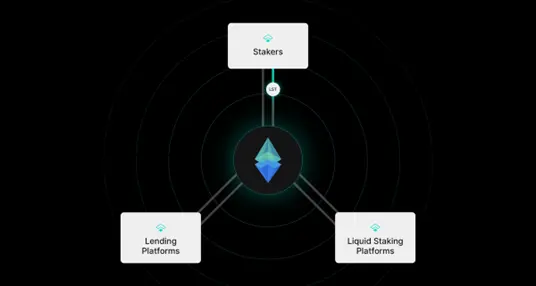
Ensure on-chain interest rate efficiency: tETH holders actively influence the on-chain market by aggregating interest rates to Ethereum’s “risk-free” interest rates.
Democratize fixed income arbitrage opportunities:tETH enables users to participate in arbitrage strategies that are usually only available to institutional investors.
Support decentralized quotation rate (DOR): By holding tETH, users help enhance the crypto-economic security of DOR.
- Revenue optimization

tETH = LST +Market efficiency gain + points
The income generated by tETH comes from liquid staking tokens (LST) and is further enhanced by interest rate arbitrage opportunities in lending agreements.
How it works:
- Basic income
tETH uses LST as the underlying asset, and LST itself generates profits. This gain is further enhanced by interest rate arbitrage strategies in lending agreements. - Enhance income through borrowing
LSTs supporting tETH may borrow ETH as collateral based on security mechanisms and profitability assessments. The borrowed ETH is converted to LST to obtain additional Ethereum Proof of Stake (PoS) rewards, effectively amplifying the overall returns of tETH while helping to gather diversified interest rates. - Additional rewards
In addition to the underlying earnings, tETH holders can also receive rewards from points activities.
- Token accounting
- Unit of measurement
tETH is measured in wstETH. - Value adjustment
tETH is a value accumulation receipt token that represents the underlying asset share held by the user in the tETH pool. - Profit distribution
The income generated by assets in the tETH pool is allocated to tETH holders once a day. This earnings allocation is reflected in the tETH:wstETH exchange rate, which is updated periodically on the "Dashboard" page. - Synchronization mechanism
The frequency of exchange rate updates in dApp is intentionally limited to ensure synchronization with the rebase scheduling of the underlying liquid staking token (LST). This synchronization helps to maintain the accuracy of the tETH exchange rate relative to the value of its underlying asset. - Balance maintenance
Unless a new deposit or redemption is made, the user's tETH balance will remain unchanged. This stability ensures that the value of tETH accurately reflects the underlying assets in the pool and the benefits generated over time.
- Unit of measurement
- Deployment process
By depositing ETH or liquid staking tokens (LST), users receive tETH proportional to their share in the overall tETH pool, representing their equity in the pool. The protocol then performs a series of rebalancing operations to obtain real benefits through arbitrage, including:
- Convert and Packaging
Native ETH deposits will be automatically converted to LST. LST deposits can also be packaged for further use in earnings optimization strategies. - Leverage operation on DeFi platform
Leveraging the protocol’s security mechanism and profitability assessment, LST can be used as collateral to borrow ETH on the lending DeFi platform. The borrowed ETH is converted to LST, further enhancing the gains of tETH through additional LST exposure. - Interest rate convergence
tETH holders gain profit enhancements by helping to converge the fragmented ETH rate market to Ethereum’s “risk-free” interest rates. - Re-staking and decentralized quotation rate (DOR)
In the future, tETH's underlying assets will be restaked to ensure DOR, allowing users to potentially receive more rewards. - Redemption process
On Treehouse dApp, redemption of tETH will be done through a liquidity pool, involving on-chain exchange to wstETH via a tETH/wstETH curve liquidity pool.
Treehouse will help facilitate redemptions that exceed the value of the Redemption Band.
Redemption Band refers to the redemption operation between 0 wstETH and 200 wstETH.
In order to maintain liquidity and reduce slippage in the liquidity pool of the tETH/wstETH curve, if the number of redemptions exceeds the redemption bandwidth, users can choose to interact directly with Treehouse. Through this process, users can destroy their tETH and obtain the corresponding underlying asset share according to the current tETH:wstETH exchange rate displayed on the dApp.
However, such redemption operations will be subject to a extraction cycle of approximately 7 days. This time gives the protocol enough time to convert the underlying LST assets back to native ETH to complete the redemption request.
- The hook protection mechanism (PPP) owned by the protocol
The tETH:wstETH exchange rate on Treehouse dApp is designed to accurately reflect the intrinsic value comparison between tETH assets and wstETH. Currently, many protocols allow users to directly exchange their LST or LRT as underlying assets, but impose withdrawal cycles. This practice can cause problems in times of high market volatility, as the protocol relies solely on market forces to determine the price of LST or LRT, even if the underlying assets are sufficient.
tETH The unique role of asset redemption
Through the protocol-owned hook protection mechanism (PPP), Treehouse assumes exclusive responsibility for converting tETH into its underlying assets.
If tETH:wstETH is decoupled in the liquidity pool of tETH/wstETH curve, causing the intrinsic value of tETH to exceed its market price, Treehouse will step in and use the Treehouse insurance fund to purchase tETH from the open market for instant redemption. This mechanism provides the following benefits for tETH holders:
- Fair intervention: Especially during times of high market volatility, Treehouse is able to perform this role fairly. By acquiring tETH from the open market, Treehouse demonstrates confidence in the value of underlying assets.
- Redistribution of income: In decoupling events, the benefits typically captured by market participants through arbitrage will in turn benefit existing tETH holders, agreements and enhance liquidity (see Profit Allocation below).
Profit distribution
Profits generated from protocol-owned hook protection mechanisms (PPPs) operations will be distributed as follows to support various aspects of the protocol ecosystem:
- 25% allocated to Treehouse Insurance Fund;
- 25% allocated to the tETH/wstETH curve liquidity pool;
- 25% allocated to existing tETH holders as arbitrage gain;
- 25% allocated to Treehouse Treasury.
- Profitability assessment
Utilization rate
Treehouse will implement an internal interest rate to manage the utilization of lending ETH. This ensures sustainable borrowing costs and addresses the challenges that volatility in borrowing demand on lending platforms.
Internal Utilization - Upper Limit
This interest rate acts as a preventive threshold and is intended to address in advance the lending platform’s ETH treasury utilization is close to levels that may lead to adverse lending costs. When the actual utilization of the lending platform exceeds the upper limit of the internal utilization of the protocol, Treehouse will rebalance to mitigate the potential impact, thus protecting the strategy of tETH.
Loan repayment strategy
The protocol continuously monitors the utilization of ETH vaults. For example, for Aave, the system triggers intervention when the internal utilization upper limit (>89%) is broken and remains above this threshold for more than two days. This approach aims to distinguish temporary volatility from stable trends, which require protocol intervention.
Treehouse continuously calculates the number of LSTs that need to be converted to ETH to keep utilization within a predetermined range. Nevertheless, if utilization increases further during the LST to ETH conversion window (e.g., from 90% to 91%), the protocol recalculates and prepares additional LST for conversion. This ensures that the repayment amount always adjusts utilization and moves towards the internal optimal level.
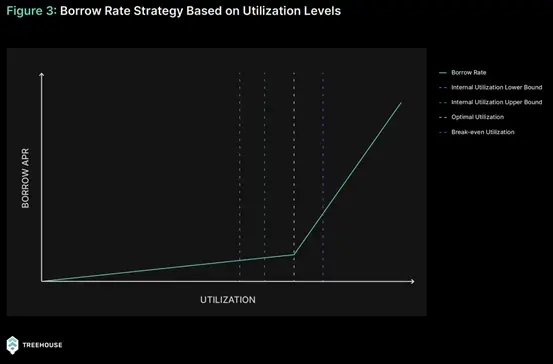
Summarize
Treehouse offers many advantages in DeFi and earnings optimization through innovative tETH, DOR and PPP mechanisms, especially in interest rate arbitrage and market stability. However, its complexity and the risk of relying on the DeFi platform may put some users in challenges. Overall, Treehouse is suitable for users who can understand its mechanisms and are willing to participate in complex operations, and may not be entirely suitable for users seeking simplicity and fast liquidity.
3. Industry data analysis
1. Overall market performance
1.1 Spot BTCÐ ETF

(East Time November 1) Total net outflow of Ethereum spot ETFs 10925,600 US dollars
1.2. Spot BTC vs ETH Price Trend
BTC
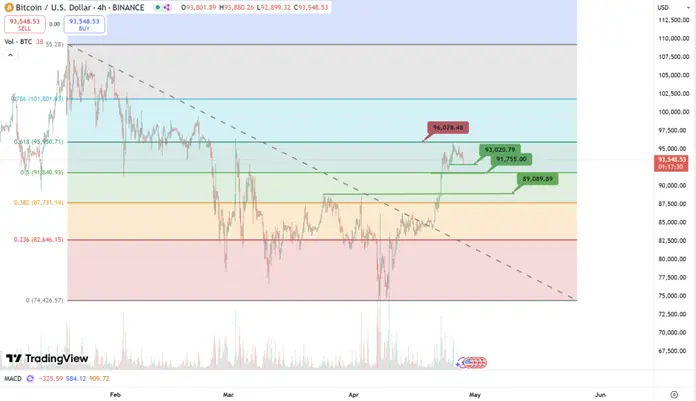
Analysis
Last week, BTC was blocked from the price range near $96,000 after continuing to rebound and break through the two important resistance zones of $89,000 and $91,000. It is not difficult to see from the figure that $96,000 coincides with the Fibonacci resistance line, which means that there is strong selling pressure near this price. Therefore, for users, the support that needs to be paid attention to in the short term can be temporarily seen to $93,000. However, given that there is no high-density chips near this support, the probability of being fallen is relatively high. Focus on the strong support of the second line of $91,700. If it does not break, continue to pay attention to the strength of the next round of rebound. If the volume goes down, it can be directly viewed to the strong support range of $87,700 to $89,000. If there is no major negative stimulus on fundamentals this week, the above areas can be regarded as a solid short-term bottom.
ETH

Analysis
For ETH, rebound is still difficult because there are many strong resistances in the above aspects. Among them, the most recent first-line resistance can be paid attention to US$1,860, followed by US$1,960 second-line resistance and US$2,100 third-line resistance. According to the current uncertain trend of fundamentals, it is difficult for the rebound this week or even next week to break through above US$2,100 for the time being.
As for support, short-term support can be paid attention to US$1,760. If it falls below, you can directly see the strong support of the neckline of US$1,700. If the pullback stabilizes near the area, you can continue to be optimistic about the second rebound and test the range of US$1,860 to US$1,960.
1.3. Panic & Greed Index

2. Public chain data
2.1. BTC Layer 2 Summary

Analysis
Stacks' Nakamoto upgrade was officially launched on April 22 to solve network congestion and decouple Stacks' block production from the Bitcoin main chain. This upgrade will introduce a new block production mechanism and update its unique transfer consensus algorithm. The new block "signer" will begin to go online to verify "term" transactions. This process will be "practice" before the upgrade is fully activated.
Stacks’ goal is to introduce greater utility, such as smart contracts and other decentralized finance (DeFi) capabilities, leveraging Bitcoin as the base layer. To this end, Stacks also launched sBTC, an asset pegged to Bitcoin 1:1, allowing users to bridge BTC into the Stacks ecosystem.
Prior to the Nakamoto upgrade, Stacks’ smart contract deployment reached new all-time highs, with more than 1,400 monthly deployments showing developers’ confidence in the Stacks ecosystem. In addition, Stacks' native token STX has risen by more than 16% in the past 24 hours, entering the top 25 market cap for the first time, showing the market's positive reaction to the upgrade.
2.2. EVM &non-EVM Layer 1Summary
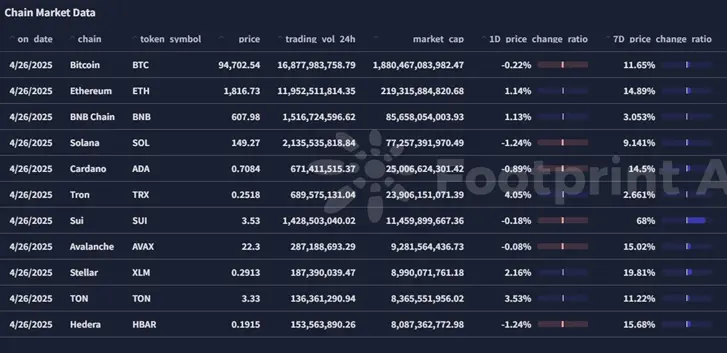
Analysis
EVM Layer 1 Blockchain dynamics
- EVMOfficially launched
EOS Network Foundation successfully launched its EVM mainnet on April 14, claiming its performance as the "fastest EVM" and can handle more than 800 swaps per second, three times faster thanSolanaand BNB and 25 times faster than Avalanche.
- TelosLaunching the ZK-EVM roadmap
Telos Foundation announced that it will fully integrate SNARKtor in 2025, adopt hardware acceleration technology, use TLOS as a native token, and roll it on Ethereum.
- Polkadot Supports EVM and Solidity
Polkadot's 2025 roadmap is released, and plans to support EVM and Solidity, adopt a multi-core architecture to improve scalability, and upgrade cross-chain messaging through XCM v5 to improve interoperability.
Non-EVM Layer 1 Blockchain Dynamics
- Solana Improve transaction throughput
Solana's non-voting transaction throughput has continued to grow over the past year, with an average throughput expected to exceed 5,000 transactions per second by 2025, with a peak likely higher.
- N1Blockchain is about to go online
The N1 blockchain confirms the support of the original investors and plans to go online in the main network in the next few months. The platform supports multiple programming languages and is designed to provide a decentralized application platform with ultra-low latency and high throughput.
- W ChainStart Layer 1 Mainnet soft start
W Chain launched the soft launch of its Layer 1 mainnet in Singapore, which is scheduled to be fully launched in March 2025. The platform is designed to be a central hub for digital currencies, ensuring seamless interoperability to meet evolving business needs.
2.3. EVM Layer 2 Summary

Analysis
Ethereum core layer: EVM evolution proposal
On April 21, Ethereum co-founder Vitalik Buterin proposed to replace the current EVM with a new execution environment based on the open source RISC-V instruction set. He believes that this can "greatly improve Ethereum execution layer efficiency", reduce interpretation overhead, and simplify the execution environment.
He simultaneously released a phased plan to gradually phase out existing EVMs while maintaining compatibility with Solidity and Vyper, and supporting faster zero-knowledge proof generation, reducing the resource requirements of Layer 2 Rollup.
zkSync: Security incidents and recovery
On April 22, the zkSync security team disclosed that the attacker used a vulnerability in the project's airdrop smart contract to mint about 111 million ZK tokens, resulting in a loss of about $5 million in the protocol funds.
By April 24, the hackers accepted a 10% bounty clause during the "safe harbor" period and returned nearly $5 million in stolen assets, marking a basically successful resolution of the incident, and demonstrating the effectiveness of zkSync's bounty processing process through the Security Council intermediary.
Polygon Agglayer: Value accumulation and Breakout incubation plan
On April 22, Polygon released the "POL Value Accumulation #1" report, showing how POL staking can power both Polygon PoS chain and Agglayer, allowing stakeholders to receive rewards across chains, and strengthen liquidity incentive mechanisms.
Then on April 24, Polygon Labs officially launchedAgglayer Breakout Program, This is an incubator project supported by the Polygon Foundation, provides financial, technical support to participants, and distributes airdrops of 5–15% project native tokens to POL stakers to support high-potential on-chain projects and further binds ecological growth to the interests of token holders.
Arbitrator: Exit NVIDIA AI Accelerator Program
On April 27, the Arbitrum Foundation announced its withdrawal from the NVIDIA Ignition AI accelerator program due to controversy over brand use. This reflects the certain friction between blockchain projects and traditional technology companies in cooperation.
Previous reports have pointed out that Arbitrum has completely withdrawn from NVIDIA's AI project, which has aroused market attention to Arbitrum's external cooperation strategy and its impact on ARB token sentiment.
Optimism: Governance and the 14th upgrade proposal
Optimism Collective is ready to executeThe 14th on-chain upgrade (Upgrade #14), that is, the deployment of the Isthmus L1 contract and MT-Cannon, is scheduled to be completed through a multi-signature ceremony on April 25, 2025.
If the proposal is approved, this will become an important step in the Optimism multi-chain governance blueprint, laying the foundation for the evolution of Superchain architecture, and improving the Sequencer contract and core basic modules.
4. Macro data review and key data release nodes next week
The final value of the Consumer Confidence Index (University of Michigan) in April 2025 was 52.2, down 8% from 57.0 in March, and fell for the fourth consecutive month, reflecting the intensified consumer concerns about the economic outlook. As of the week ending April 19, the number of initial unemployment claims in the United States recorded 222,000, 222,000 in line with market expectations, higher than the previous value of 215,000, indicating that the overall labor market is still resilient.
This week (April 28-May 2) important macro data nodes include:
April 30: U.S. first quarter GDP initial value, U.S. core PCE price index annual rate in March
May 1: Bank of Japan interest rate resolution, US April ISM manufacturing PMI
V. Regulatory policy
Russia
Launching cryptocurrency exchanges for elite investors:Russia will launch state-backed cryptocurrency exchanges for elite investors to facilitate crypto asset trading and support market development in a controlled environment.
South Korea
Actively participate in the formulation of stablecoin regulations:The Bank of South Korea announced that it will actively participate in the formulation of stablecoin-related regulations to prevent currency and financial stability risks, protect investors and ensure financial stability.
Panama
Support cryptocurrency payments for municipal fees:Panama City announced that it will accept cryptocurrencies such as Bitcoin (BTC), Ethereum (ETH), USDC, USDT to pay municipal fees (such as taxes, bus tickets, etc.), and will be officially launched after the technical connection is completed, promoting the implementation of cryptocurrency applications.
Puerto Rico (U.S. territory)
Tax bills against cryptocurrency tax avoidance:U.S. lawmakers have proposed the Puerto Rico Digital Assets Fair Tax Act, aiming to strengthen supervision of crypto assets taxes and curb the use of Puerto Rico as a crypto tax haven.











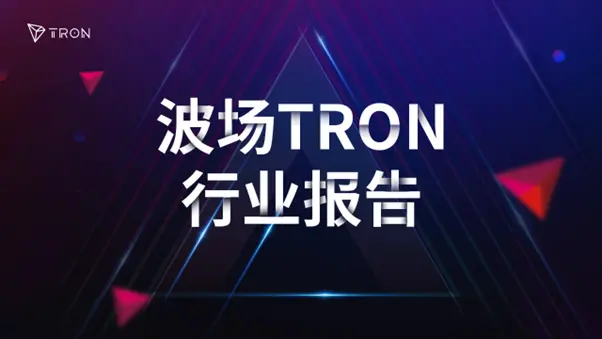
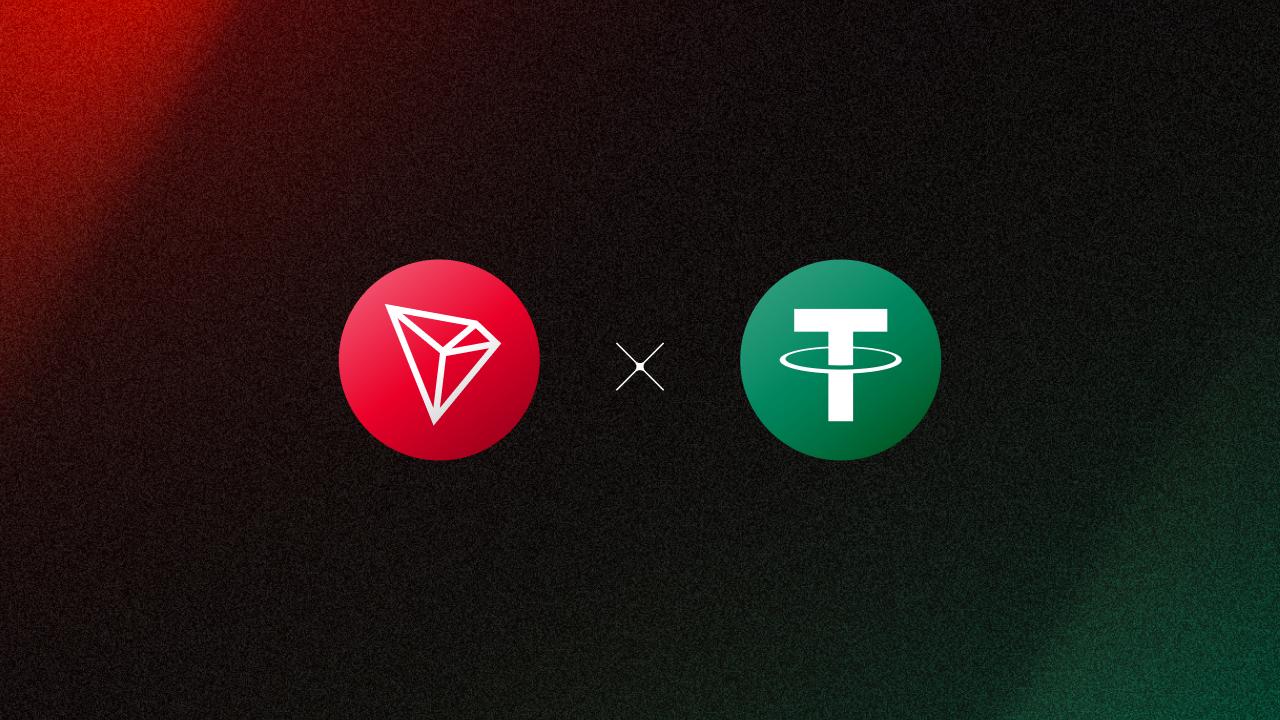
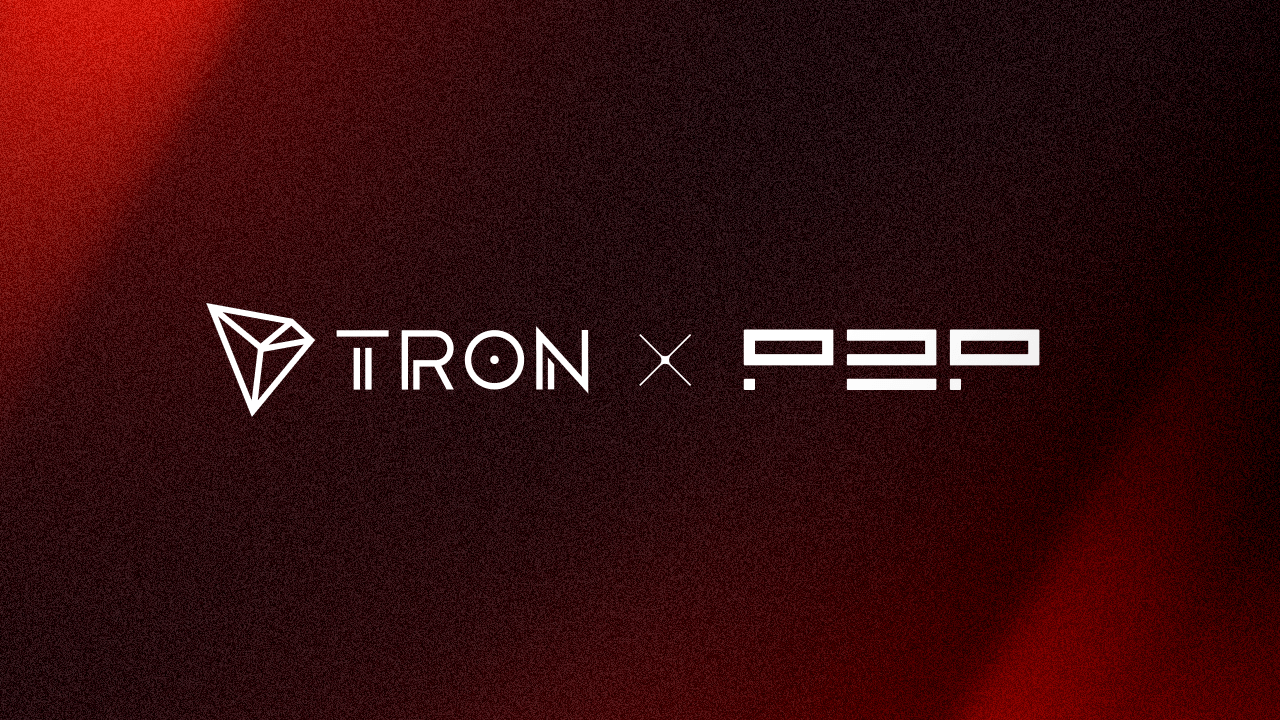
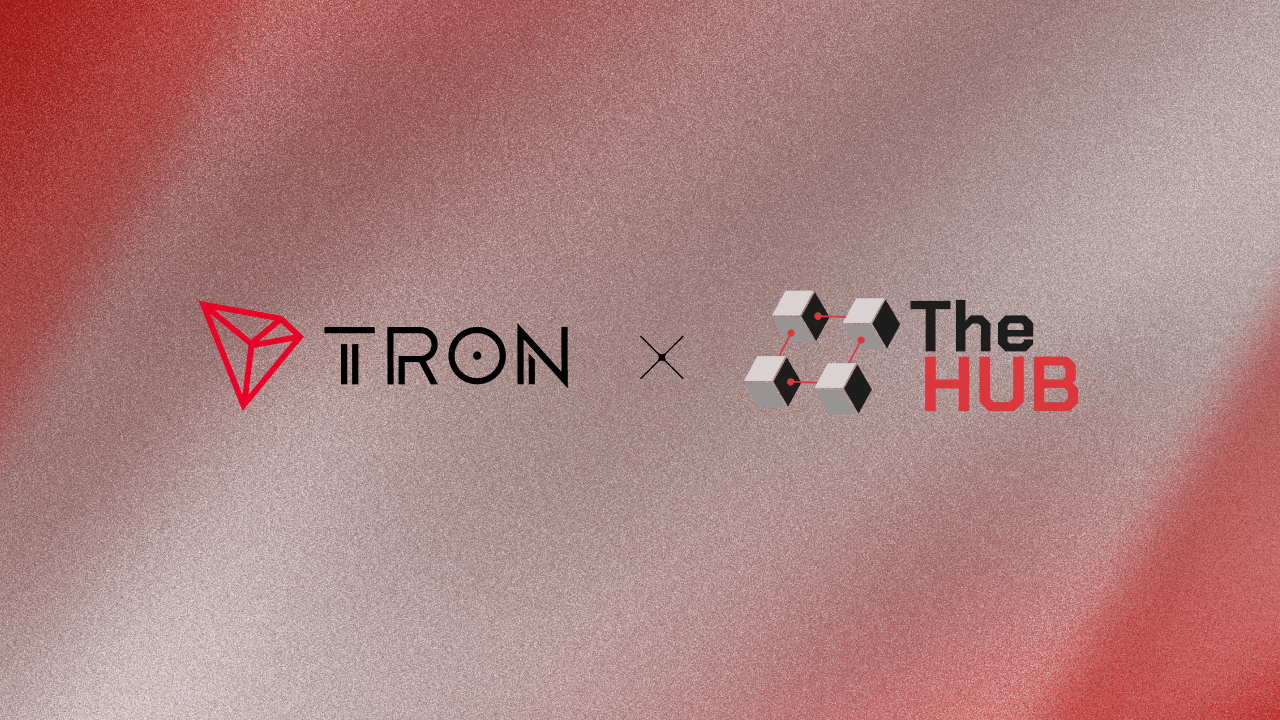

No comments yet